THE JOYS OF JANUARY
As these words are being written the weather is enough, to borrow from Grandpa Joe, to “give a fellow a bad case of the mollygrubs.” It’s grey and grim outside, with rain falling and constant pings on my computer alerting me to worse to come from the elements. Mind you, Grandpa and indeed most any rural mountain resident of his generation could have done pretty much as good a job as today’s prognosticators with nothing to guide them except animal behavior, cloud formations, observations of long-range “predictors,” and all too powerful aches and pains. I can’t match most of their ability to read signs (my loss) but I can readily identify with the “miseries” (Grandpa’s term) when it comes to aching joints.
Nor have I ever bothered to record and track the “ruling days,” as mountain folks in yesteryear described the period between Christmas Day and Epiphany (January 6, also known as “Old Christmas”). But the basic concept involved equating the weather on each of those days with that for the corresponding month to come. In other words, the weather on December 25 would predict that for January, that of the next day would provide a forecast for February, and right on through until Epiphany and the forecast for the next December. Yet lots of old timers swore by the ruling days, and I’ve seen enough of their folk wisdom translate to practical reality to know better than to deny the concept of the ruling days when it came to weather for the next years. Since these words are being written on Epiphany, I reckon you can, by this approach to weather forecasting, conclude that December of 2025 will be cold, wet, and right down miserable.
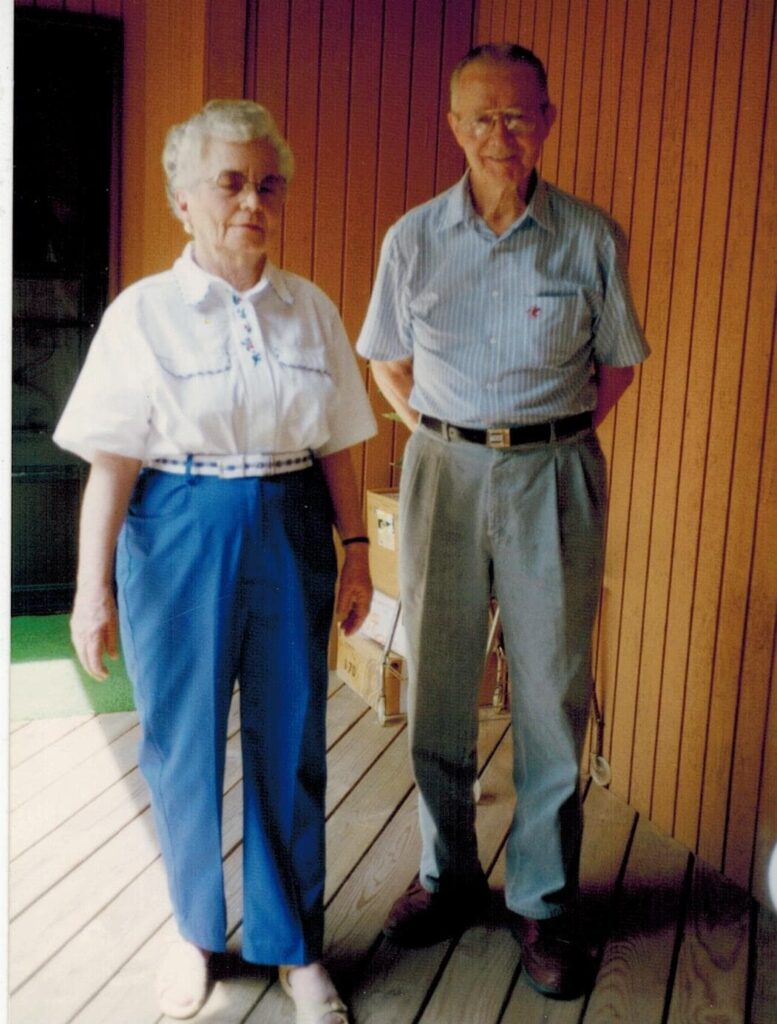
That dismal forecast notwithstanding, I always think of January primarily with delight. It was the month of my birth, a time in boyhood when I had a fine spell of hunting at the beginning of the month before classes resumed, invariably a Christmas gift or two to try while out hunting small game, and of course the challenges of a New Year. About the only exception to this general perspective is the fact that my father died right at the end of January. It’s difficult for me to believe he’s been gone a decade and a half, but he had a wonderfully full life of 101 years, his mind was sound right to the end, and there isn’t a day that passes when I don’t have some reason to remember him and be thankful. The same is equally true of my mother. I was wonderfully blessed in the time and place where I grew up, but a pair of loving, hard-working, caring, and sensible parents was an even greater blessing. Those considerations always come on strong in my mind in January, and that explains my choice of the word “joy” in the title of this month’s offering.
Here are some of the joyful moments bubbling through the caldron of my mind as we settle into January—most from old long ago but some of more recent vintage.
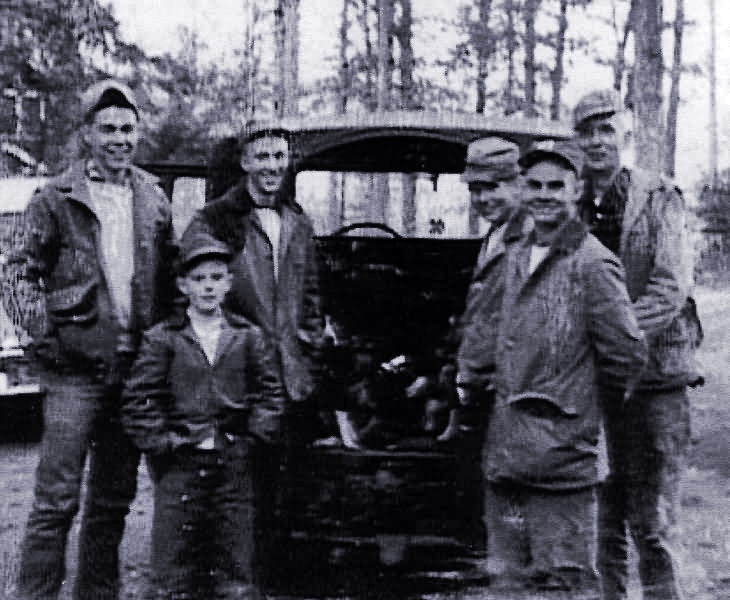
*Solitary “mixed bag” hunts on snow days when school was closed. With whatever beagles happened to populate our dog lot I would set out for a day of hunting. Rabbits were the primary quarry but I could pretty much count on bumping into a covey or two of quail sometime during the day, and woe be unto any squirrel that presented so much as a glimpse of his bushy tail. Incidentally, I use the term “dog lot” advisedly. Our economic circumstances and life style didn’t run to anything as high drawer as a kennel. Instead we either had wires with the dog attached by a sturdy lead (usually some kind of light chain) or a cobbled together pen. In each case there would be a homemade dog house with cedar shavings that were replenished on a fairly regular basis.
*Sledding. At some point in my boyhood Daddy crafted a sled with wooden runners and frame that was in effect a miniature version of similar sleds he would have used in boyhood for moving rocks, hauling wood, and other tasks. These were horse- or mule-drawn, but ours were for snow. With their fixed runners and absence of any steering mechanism the sleds were a matter of “hang on for dear life” when you headed down a snow-laden hill. In most cases there would be a level space at the end of the run where you coasted to a stop, but if not, as was the case with the hill nearest our house which ended at a thick growth of floribunda roses and blackberry briars, the options were to bail out at the last moment or else get thoroughly scratched on any exposed are. Some of those sled rides in my teen years involved girls, and I remember joining a couple of my rabbit hunting buddies for a sledding triple date where we all crammed into a jeep, had a wonderful time sledding on the hilly nine-hole local golf course, and then being denied a good night kiss with the explanation: “I never kiss on a first date but you can hold my hand for a minute.”
*Basketball. I was a member of the high school basketball team, and we were really good. In fact the team from my junior year is enshrined in the Swain County High School Athletic Hall of Fame, so I can truthfully claim that I was a hall of fame basketball player. The flip side of that was that my role was one of bench warmer with any contribution I made to team success involving furnishing opposition for practice scrimmages. A year or two after I graduate I was more than adequately skilled in the sport to have been a starter, but for all my youthful love of the sport there was one insurmountable barrier. I entered my senior year in high school standing just a couple of inches over five feet tall and weighing about 120 pounds. Puberty and the typical growth spurt of adolescence came much later for me than it does for most. In fact, I grew some five inches between when I graduated from high school and completed my freshman year in college.
*Ice skating. I’ve only had a pair of ice skates festooned with blades on two or three times in my life, and one of those was a college date where both my partner and me must have been a sight to behold. I saw her at a college reunion a few years back, and she had the same vivid, somewhat embarrassing memories of that skating date that I did. In high school the “skating” involved sliding on a frozen pond or maybe a stretch of sidewalk that had been intentionally sprayed with water when temperatures were well below freezing. If you could make a bit of a running start without losing your balance it was possible to glide for yards. Alas, one such experience has meant problems for me ever since. A fellow teenager, with typical unthinking boisterousness, pushed me from behind unexpectedly. I fell flat on my face and my top four front teeth were knocked almost completely out. They just dangled by threads of flesh. Fortunately, there was a local dentist far ahead of them times (this was in the late 1950s) who came to the little local hospital where Daddy took me. He somehow managed to save the teeth, although all later required root canals. Two of the four are now gone, replaced by a partial plate. That little incident, over time, has translated to many thousands of dollars in dental work and no small measure of pain.
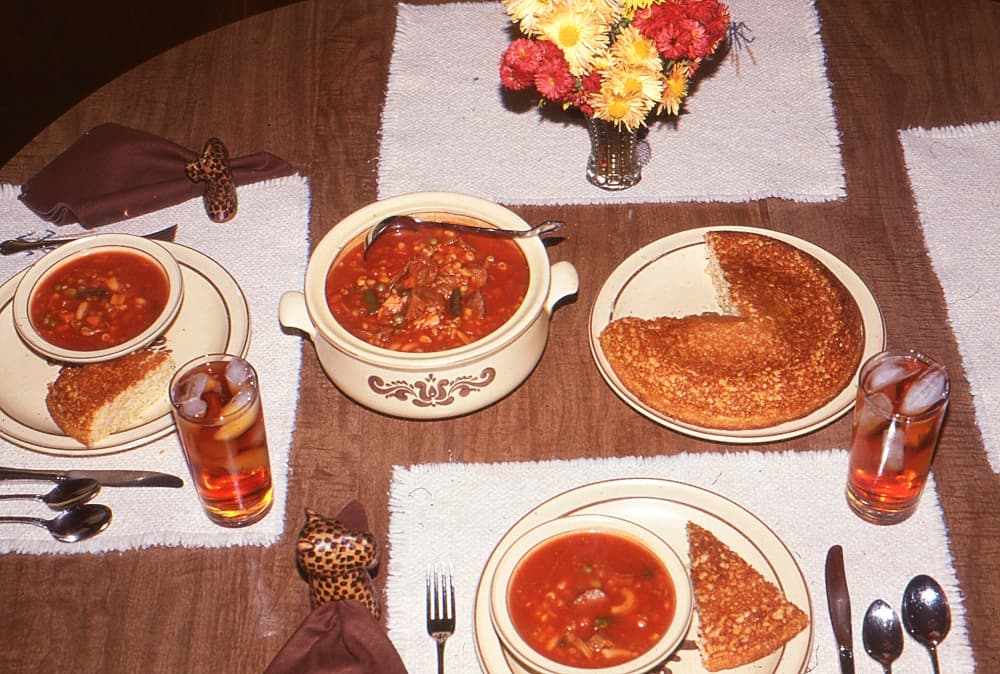
*Hearty fare cooked by Momma or, occasionally, Grandma Minnie. I have particularly fond memories of soup laden with vegetables we had canned, tomato juice, and enough store-bought hamburger to give it a meaty flavor. That approach to soup remains a favorite with me, although I substitute ground venison for the hamburger and V-8 juice for the tomato juice (see recipe below). Accompanied by a pone of cornbread, this made a hearty and inexpensive meal. I never thought about the latter but now know that it was of importance to the family budget and that Momma was a genius at making a pound of hamburger do a rather respectable version of the Biblical loaves and fishes (see recipe section below for my version of her hamburger gravy). If rounding this meal out there were fried apple pies or maybe, on rare but wonderful occasions one of Grandma’s stack cakes for dessert, then a mountain boy was on the backside of culinary heaven (see recipes for fried pies and stack cake below).
*Another soup Momma made with some frequency on cold winter days, especially when one of my siblings or me was feeling poorly, was potato soup. It was easily prepared, would in my Grandpa Joe’s words, “stick to a fellow’s ribs,” and inexpensive. All those factors, along with the fact it was genuine comfort food without the added cost of meat, translated to pure goodness on a mountain table. In fact, I guess you could describe it as high country soul food, because it was that central to mountain diet as I knew it when a lad (see recipe below). Incidentally, a gratifying number of you respond to these scribblings, and one of the most common themes in those responses focuses on shared memories. I would love to hear about your food memories from yesteryear or your thoughts on cherished seasonal foodstuffs in general.
*The carefree lifestyle of a heedless, incredibly naïve hillbilly boy. At various points in my life folks have referred to me, usually in jest but on two or three occasions in derision, as a hillbilly. Far from being offended or feeling I was the butt of some joke, I wear the term as a badge of honor. I was a son on the high hills of the Smokies, grew up in a culture that was distinctly Appalachian though a far cry from stereotypes such as Snuffy Smith or Li’l Abner in the comics or TV’s Beverly Hillbillies. As a teenager I thoroughly enjoyed school and had, for the most part, first-rate teachers with a degree of devotion too seldom found in today’s world. I didn’t study as hard as I should have but still managed to do well in everything except behavior. For whatever reason, although boredom may have been part of the picture, my comportment left a lot to be desired. There’s a notation on one of the report cards from my senior year in high school to the effect that multiple teachers had referred me to the principal at some point during the year.
I had branched out from consuming interest in things such as hunting and fishing, stamp collecting, and reading to become quite interested in the fairer sex. My junior and senior years saw me dating quite a bit (almost always double dates if transportation was involved), go through at least three “steady” girl friends (that suggests my amorous behavioral patterns were anything but steady), and in general exhibit the often irrational, frequently irritating, and invariably unpredictable behavior typical of teenagers then and now. On the plus side I worked full-time jobs in the summer, never shied from chores at home (not that I had much choice), and was blessed with parents you imbued me with a solid work ethic and sense of what was right and proper never mind my tentative excursions into realms of unacceptable things.
All things considered, I had a blessed youth, and except for being “raised right” probably the biggest of those many blessings was geographical. Mine was a highland homeland and it remains and ever will be the home of my heart. Cold January days are a good time for such memories.
************************************************************************
THIS MONTH’S SPECIAL OFFERINGS
On a daily basis walking through the large room where I have books for sale arranged, and doing the same for volumes in a separate storage shed, reminds me of the fact that I need to get rid of a lot of this stock. With that in mind, any book on my extensive list of works on turkey hunting that is price at $50 or less can be bought for 25% off and I’ll pay the postage if you buy two or more books. The same offer is also available for books on Africa (a separate list). If you only buy a single item, postage is an additional $6. You can access the list, along with a number of others, by visiting my website (www.jimcasadaoutdoors.com) and clicking on the turkey or Africana list. If you encounter any problems in accessing the lists, let me know. Since use of my PayPal form is set up to enter books at the listed price, you’ll need to take one of two alternative steps to order books. I would prefer that you just send me a check for the amount, being sure to tell me what book or books you are order. Or you can send me the necessary amount via PayPal and add a personal message saying what it is for. My mailing address, if you pay by check, is: Jim Casada, 1250 Yorkdale Drive, Rock Hill, SC 29730.
************************************************************************
JIM’S DOIN’S
The latter part of December on into the beginning of this month saw me relaxing a bit, taking care of ear’s end details such as gathering tax records and checking my calendar for the coming months, and enjoying a couple of days with my daughter, son-in-law, and granddaughter. I ate way too much fine food (my sole contribution was making a batch of biscuits), reveled in seeing family open presents, and was delighted in the things I received. I’m pretty much a study in impossibility when it comes to gifts, since I don’t want much and when I do want something I just get it. However, I received all three of the things I suggested—a high-end, idiot-proof Warthog knife sharpener, a Lamson meat cleaver, and some pasta bowls. They’ve seen meaningful service already. Also, dear friends Darrin and Robin Dawkins, just as bamboozled when I came to gifts for me as my family, presented a gift certificate for a local eating establishment I greatly enjoy but almost never visit because, and I don’t know any way to say it except laying it on the line, they are too pricey for my style. Things are quite like what Daddy once uttered when told what a cake he’d been paying $10 for would cost five times that amount in a bakery (“That price would sour my stomach so bad I couldn’t eat”). I guess being raised in a time and family where budgeting was essential, then knowing tough financial times for a few years after marriage gave me a lifetime proclivity for pinching pennies a bit. It’s a trait for which I offer no apologies whatsoever. There were some items of attire, a book of crossword puzzles, and scrumptious edibles my granddaughter picked up at a country market in a small east Tennessee community near where she’s in graduate school.
I still try to do at least some writing daily and anxiously await word from a university press regarding their final thoughts on my book manuscript, “Profiles in Mountain Character.” There was the normal run of published material including my weekly column in the Smoky Mountain Times and a number of articles. The latter were “Venison’s Many Marvels,” South Carolina Wildlife, Nov./Dec., 2024, pp. 54-55; “Traditional New Year’s Fare,” Smoky Mountain Living, Dec., Jan., 2024-25, pp. 14-17; “Rowland Ward: Entrepreneur, Publisher, Big Game Guru and Taxidermist,” “Sporting Classics Daily,” Dec. 3, 2024; ”Abject Sadness to Enduring Gladness,” Columbia Metropolitan, Dec., 2024, pp. 122-24; ”Robert Ruark: A Man of Startling Contrasts,” “Sporting Classics Daily,” Jan. 2, 2025; and “Mountain Tough,” Carolina Mountain Life, Winter, 2025, pp. 84-85.
RECIPES
All of this month’s recipes come from food memories covered in the narrative material above, and with the sole exception of a stack cake all are comestibles I’ve sampled and savored in the last two or three weeks.
HAMBURGER (OR GROUND VENISON) GRAVY
Momma had lots of ways of stretching groceries and the foodstuffs we consumed. Much of her approach involved canning and drying, and after I was grown and gone, freezing things we raised. Also, any game we killed or fish we caught were most welcome fare. Our family ate well and always had plenty and then some. My friends and those of my siblings ate with us with an amazing degree of regularity. That was a testament not only to Mom’s ability as a cook but to her exceptional talent for making folks of all ages feel welcome and comfortable. In time her grandchildren dubbed her, with complete accuracy, as “The Spoiler,” but long before that she was spoiling pretty much any and all kids who came along.
Standard fare at our table was simple, but there was always plenty of it and it was invariably tasty. In fact, I can’t remember her ever having a flat-out culinary failure, although biscuits were not her strong point. On dish we consumed frequently, more often than not at supper, was hamburger gravy atop cornbread. There might be some fruit (stewed apples) as well, but that was it. We had our big meal in the middle of the day.
Momma’s hamburger gravy was long on taste and rather short on meat. She could turn a pound of hamburger, along with flour and milk, into a mighty hefty helping of gravy. She started out with hamburger that was almost as much fat as it was lean (about the closest you get today is a 73% lean and 27% fat blend. Mom wasn’t stuck with pre-packaged meat. She shopped at a local meat market run by a fellow named Ray Wright, and he would pretty much make hamburger to order. Momma went the cheap route, knowing that lots of fat meant a lower price AND plenty of grease for good gravy. IN today’s world the health Nazis might scream, but such thoughts never crossed her mind.
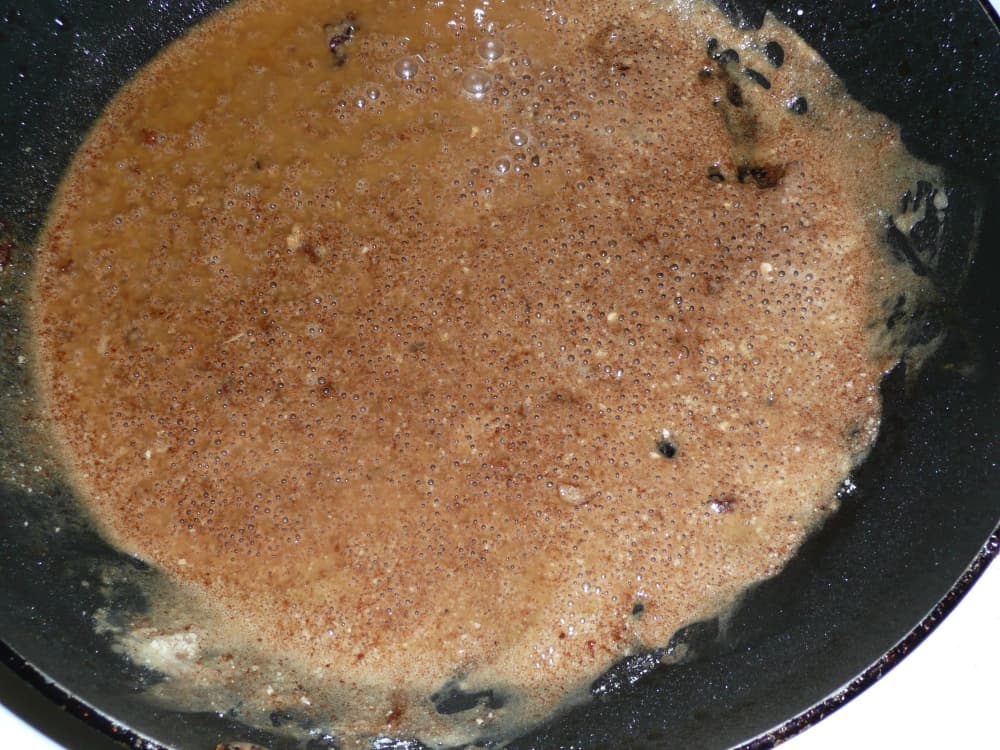
Her approach was pretty much the one described below. She would brown her meat and remove it from the big cast iron pan she had used leaving only hot fat and bits of brown. Into that grease went flour, vigorously stirred until a suitable roux had been made (I doubt if the word roux was in her vocabulary but by golly she sure knew how to lay the groundwork for fine gravy), and then began introducing milk. She could stretch and stretch this with alternating thinning with milk and thickening with flour until things suited her, seasoning with salt and black pepper as she went. At the point when her mixture was deemed ready the browned burger went back in and within less than a minute you had hamburger gravy ready to adorn crumbled cornbread. Today I do precisely the same thing with ground venison, using either suet or pork fat to get the necessary amount of grease.
HOMEMADE MEAT AND VEGETABLE SOUP
Both Momma and Grandma, my dual guiding stars in all matters related to cooking, made soup with considerable regularity. Preparation was easy, soup offered a fine way to use leftovers, and the way they prepared it meant mighty fine eating. Indeed, so prevalent on the menu was vegetable soup or vegetable beef soup both canned what they called soup mix. It was just a variety of vegetables, with chopped tomatoes and tomato juice being a sort of central ingredient. Other vegetables would include some or all of the following—lima beans, crowder peas, corn, okra, green peas, green beans, and more. With soup mix as a basis, supplemented by a quart or two of water mixed with beef stock, and either some hamburger or a soup bone, a big pot would be set on the stove, barely simmering, until all the flavors had mixed and melded.
That’s pretty much how I make soup, although I always include ground venison (it is worked up with Boston butt on about a three to one ration when the deer is being processed) as a meat base. I also use beef stock and a fairly hefty infusion of Mediterranean seasoning. Sometimes, though not always, I throw a couple of dried hot peppers into the pot. Eaten with a pone of cornbread it is filling and fulfilling.
FRIED PIES
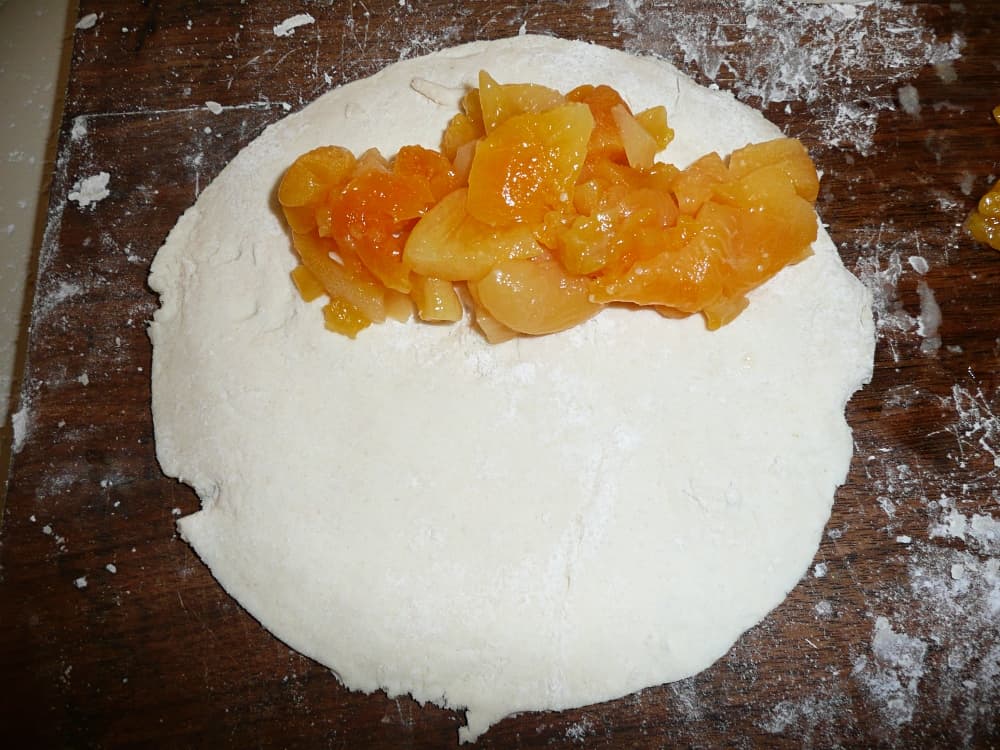
Often styled mule ears, after their shape, fried pies were a staple dessert during my boyhood. The filling varied a bit, but the most common offerings were apple and peach. Both were made with dried fruit that had been reconstituted. You can do the same thing with store bought dried apricots, and I occasionally use frozen blueberries, although they have so much juice that oozing out of the turned over pastry can be a problem. I haven’t tried using dried blue berries, I but I should because they dry quite nicely and are easily reconstituted with a bit of water. Here’s Grandma Minnie’s recipe as it is offered in mine and Tipper’s cookbook, Celebrating Southern Appalachian Food.
1 pound dried fruit
¾ cup brown sugar
2 teaspoons of cinnamon (or to taste)
2 tablespoons butter
Cover the dried fruit with water and soak overnight. Drain any extra water and cook slowly until completely tender. Mash the fruit to make a sauce and then add the other ingredients. Stir well and allow to cool. Make a pie crust but use less shortening than normal. Roll out the crust quite thin, cut in circles, add the fruit sauce, pinch edges, and fry in piping hot lard. Turn only once. Serve while still warm. If desired, you can sprinkle with cinnamon or cinnamon sugar.
SMOKY MOUNTAIN STACK CAKE
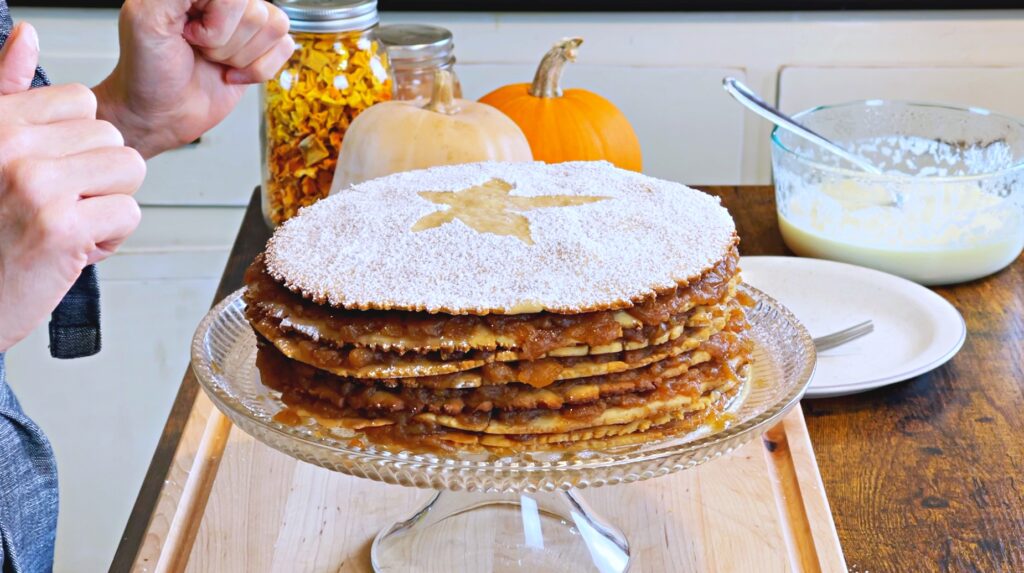
Momma never, to my recollection, made stack cakes. That may have been because they are difficult or perhaps she simply yielded to Grandma Minnie’s mastery in this arena. Early on Grandma realized I was a pure fool for her stack cakes, and well into my adulthood and her final years she would have one made for me whenever my parents told her my wife and I would be coming for a visit. It’s a mighty fond memory. The recipe below comes from Tipper Pressley, my co-author in Celebrating Southern Appalachian Food, and is taken from that book. Like Momma and Grandma, Tipper is a mountain woman who practices magic in the kitchen on a daily basis. This is a time-consuming recipe, but rest assured the end results justify every bit of the effort.
Part 1: Cake
½ cup shortening
½ cup sugar
1 egg beaten
⅓ cup sorghum syrup
½ cup buttermilk
3½ cups all-purpose flour
½ teaspoon soda
½ teaspoon salt
1 teaspoon ginger
1 teaspoon vanilla
Cream together sugar and shortening. Add egg, sorghum, vanilla, and buttermilk, mix well. Sift together flour, soda, salt, and ginger. Make a hole in dry ingredients, add creamed mixture and stir until the consistency is like soft cookie dough. The next step is making the cake layers. Divide dough into 7 equal parts. You’ll need to add additional flour as you roll out the dough to make the layers. Roll each layer into a 9-inch circle. Bake layers at 350 degrees for 10 to 12 minutes or until light brown around the edges. Set cooked layers aside to cool.
Part 2: Apple filling
1 pound of dried apples (14 cups of dried apples)
water
1 cup brown sugar
½ cup white sugar
1 teaspoon cinnamon
¼ teaspoon cloves
½ teaspoon allspice
Put apples in a pot with water and cook; keep a fairly close eye on the apples as you may have to add additional water while they cook. Once apples are soft enough to mash, add the other ingredients and mix well.
Part 3: Assembly
Place a cake layer on a cake plate and spread with apple filling. Repeat until you reach the last layer. Whether you put apple filling on the top layer is up to you. Many cooks use cooked apples to frost the entire cake. I like to leave the top layer bare and sprinkle powdered sugar on it in a pretty shape. Allow cake to sit overnight before eating. This enables the apple goodness to soak fully into the cake layers.
Part 4: Custard Sauce
4 egg yolks
½ cup sugar
2 cups half-n-half
1 teaspoon vanilla
pinch of salt
Custard sauce is not part of the traditional apple stack cake recipe, however in my opinion it makes a good thing an even better thing. To make the sauce: beat yolks in a metal bowl that will fit over a saucepan in the manner of a double boiler. As you beat the yolks, add sugar a little at a time. Once sugar is added, increase the mixer speed scraping bowl as needed and beat until mixture is thick and lemon colored. Add half-and-half and mix well. Move bowl over saucepan of simmering water. Cook custard over water stirring often until mixture is thick enough to coat the back of a spoon. Add vanilla and salt. Remove from heat and cool before serving. This is a thin custard, which makes it perfect for pouring over a piece of cake.
Part 5: Eat
After the apple stack cake has sat overnight slice a piece and drizzle custard over it or under it or don’t drizzle custard over it or under it at all and eat!
NOTE: If you end up with more layers or less the cake will still be amazingly good! Also, while dried apples form the traditional between layers filling in stack cakes, various jams or reconstituted dried peaches will also work perfectly well.
TIP: Use the bottom of a 9-inch cake pan as a template for making cake layers by either tracing out the shape on parchment paper and rolling to size or rolling out dough and using cake pan as a template to cut the dough out.
POTATO SOUP
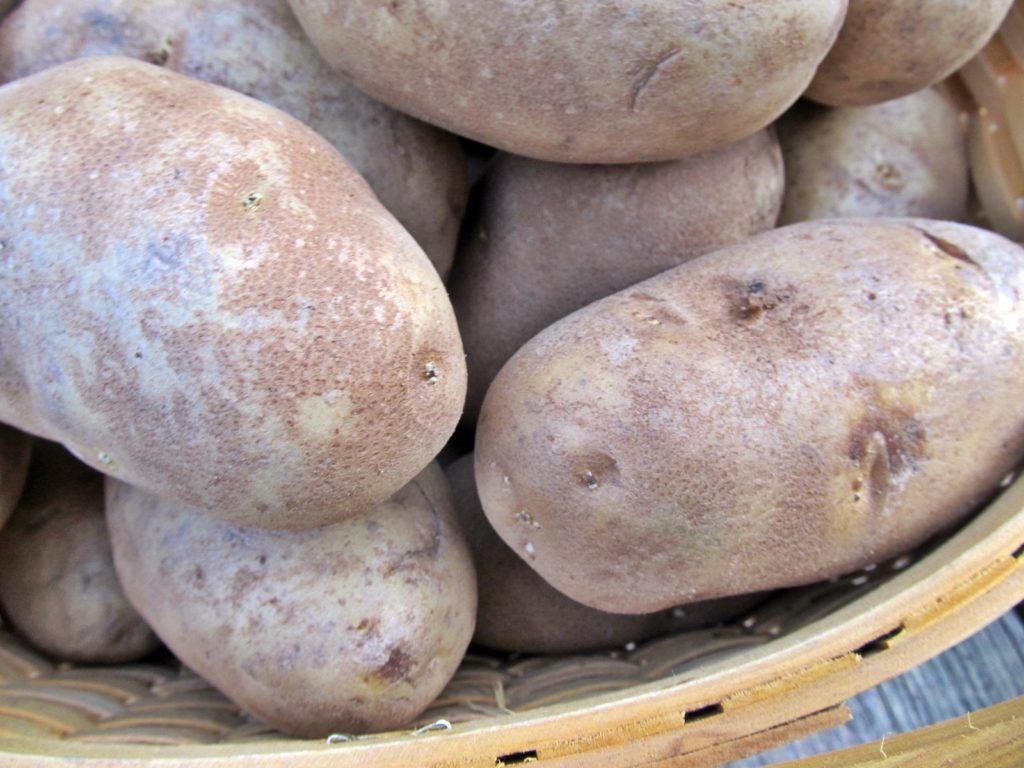
1 large potato per person, peel and cut into chunks
Enough water to cover the potatoes
Salt and pepper to taste
Butter
Milk
Boil the potato chunks until a fork sticks through them with ease. Drain some of the water, leaving a portion to mix with milk, and mash to potatoes gently. I like to leave some pieces but if you want them completely mashed up, that’s fine and a matter of personal preference. Add a hefty portion of butter and enough milk to cover the potatoes and then some. Include salt and pepper to taste, although this step can be left for individual servings if desired. Return to the stove and heat gently until the butter is melted, everything is well mixed, and the soup is piping hot. Be sure not to turn the heat up too high and that you stir steadily Milk scorches easily. Remove from the stove and serve with crackers, a chunk of cornbread, or toast points.